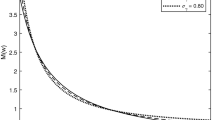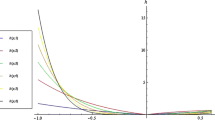Abstract
The Black–Scholes model is based on a one-parameter pricing kernel with constant elasticity. Theoretical and empirical results suggest declining elasticity and, hence, a pricing kernel with at least two parameters. We price European-style options on assets whose probability distributions have two unknown parameters. We assume a pricing kernel which also has two unknown parameters. When certain conditions are met, a two-dimensional risk-neutral valuation relationship exists for the pricing of these options: i.e. the relationship between the price of the option and the prices of the underlying asset and one other option on the asset is the same as it would be under risk neutrality. In this class of models, the price of the underlying asset and that of one other option take the place of the unknown parameters.
Similar content being viewed by others
References
Ait-Sahalia Y., Lo A.W. (2000). Nonparametric risk management and implied risk aversion. Journal of Econometrics 94, 9–51
Barone-Adesi, G., Engel, R., & Mancini, L. (2004). GARCH Options in Incomplete Markets. Working paper, University of Lugano.
Bernardo A.F., Ledoit O. (2000). Gain, loss and asset pricing. Journal of Political Economy 108, 144–172
Benninga S., Mayshar J. (2000). Heterogeneity and option pricing. Review of Derivatives Research 4, 7–27
Brennan M.J. (1979). The pricing of contingent claims in discrete time models. Journal of Finance 34, 53–68
Black F., Scholes M. (1973). The pricing of options and corporate liabilities. Journal of Political Economy 81, 637–654
Camara A. (1999). An extended set of risk neutral valuation relationships for the pricing of contingent claims. Review of Derivatives Research 3, 67–83
Camara A. (2003). A generalization of the Brennan–Rubinstein approach for the pricing of derivatives. Journal of Finance 58, 805–819
Camara, A., & Simkins, B. (2006). Options on troubled stock. Working paper, University of Michigan-Flint.
Chernov M., Ghysels E. (2000). A study towards a unified approach to the joint estimation of objective and risk-neutral measures for the purpose of options valuation. Journal of Financial Economics 56, 407–458
Cochrane J. H., Saa-Requejo J. (2000). Beyond arbitrage: Good-deal asset price bounds in incomplete markets. Journal of Political Economy 108, 79–119
Corrado, C., & Miller, T. W. (2003). The forecast quality of CBOE implied volatility indices. Working paper, Olin School of Business.
Cox J., Ross S., Rubinstein M. (1979). Option pricing: A simplified approach. Journal of Financial Economics 7(3): 229–263
Dumas B., Fleming J., Whaley R. (1998). Implied volatility functions: Empirical tests. Journal of Finance 53(6): 2059–2106
Franke G., Stapleton R.C., Subrahmanyam M.G. (1999). When are options overpriced?: The Black–Scholes model and alternative characterisations of the pricing Kernel. European Finance Review 3, 79–102
Heston S.L. (1993). Invisible parameters in option prices. Journal of Finance 48, 933–947
Jackwerth J. (2000). Recovering risk aversion from option prices and realised returns. Review of Financial Studies 13, 433–451
Jackwerth, J. C. (2004). Option-implied risk-neutral distributions and risk aversion Research Foundation of AIMR.
Liu, X., Shackleton, M. B., Taylor, S. J., & Xu, X. (2005). Closed-form transformation from risk-neutral to real-world distributions. Working paper, Lancaster University.
Pan J. (2002). The jump-risk premia implicit in options: Evidence from an integrated time-series study. Journal of Financial Economics 63, 3–50
Rosenberg J., Engle R. (2002). Empirical pricing kernels. Journal of Financial Economics 64, 341–372
Ryan P.J. (2000). Tighter option bounds from multiple exercise prices. Review of Derivatives Research 4(2): 155–188
Rubinstein M. (1976). The valuation of uncertain income streams and the pricing of options. Bell Journal of Economics and Management Science 7, 407–425
Rubinstein M. (1983). Displaced diffusion option pricing. Journal of Finance 38, 213–217
Schroder M. (2004). Risk-neutral parameter shifts and derivatives pricing in discrete time. Journal of Finance 59(5): 2375–2401
Stapleton R.C., Subrahmanyam M.G. (1984). The valuation of multivariate contingent claims. Journal of Finance 39(1): 207–228
Author information
Authors and Affiliations
Corresponding author
Rights and permissions
About this article
Cite this article
Franke, G., Huang, J. & Stapleton, R. Two-dimensional risk-neutral valuation relationships for the pricing of options. Rev Deriv Res 9, 213–237 (2006). https://doi.org/10.1007/s11147-007-9009-3
Published:
Issue Date:
DOI: https://doi.org/10.1007/s11147-007-9009-3




